Do you want to add Twitter Cards to your WordPress site? Twitter Cards are images and descriptions that appear on Twitter when someone shares your content.
It helps you control how your tweets will look on Twitter, get credit by automatically including your name in the tweet, and boost user engagement.
In this article, we will show you how to add Twitter Cards in WordPress, so your tweets can stand out.
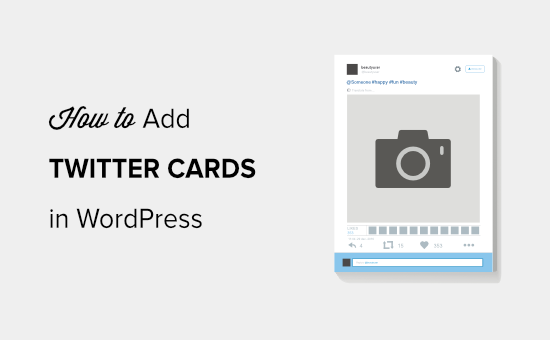
Why Use Twitter Cards in WordPress?
Twitter Cards allow you to add a title, summary, image, and video or audio file to your tweet. This way, you are more likely to get more clicks and retweets.
You can see a live example by going to our Twitter page.

The biggest advantage of having Twitter Cards is that they increase the number of people following your Twitter accounts through content attribution. Often people tweet your links without giving you proper credit.
For example, say @syedbalkhi retweets a post from @wpbeginner without attribution, and other people retweet @syedbalkhi. Then users viewing those retweets are more likely to follow @syedbalkhi than @wpbeginner.
Often content curators do this to keep the tweet lengths short and ensure retweets of their own tweets.
With Twitter Cards, this problem is solved because you get credit to your WordPress website from every tweet that mentions your article.
Now that you know the benefits of Twitter Cards, let’s take a look at how to implement them in WordPress. We will cover two methods and show you how to test and validate your Twitter Cards:
Method 1: Using AIOSEO Plugin to Add Twitter Cards (Recommended)
The easiest way to add Twitter Cards to your website is using the All in One SEO (AIOSEO) plugin for WordPress. It is the best WordPress SEO plugin and is used by over 3 million websites.
First, you will need to install and activate the AIOSEO plugin. For more details, follow our step-by-step tutorial on how to install a WordPress plugin.
You can use the free version of AIOSEO as it offers a feature to set up Twitter Cards on your WordPress website.
After the plugin is active, go to your WordPress admin area and navigate to All in One SEO » Social Networks. Then click on the ‘Twitter’ tab and make sure that the ‘Enable Twitter Card’ option is enabled.

Once you enable Twitter Cards, you can change their appearance using different settings.
AIOSEO lets you select the Default Card Type for your content. The plugin will set ‘Summary’ as the default card type, which shows the title, summary, and thumbnail image for your content.
However, you can change it to ‘Summary with Large Image’ from the drop-down menu, and Twitter will show your tweet with a large image.
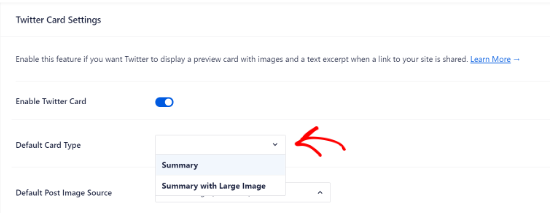
After that, you need to select the Default Post Image Source. It is the image you want to display on your Twitter Cards.
There are different options to choose from using the drop-down menu. For instance, you can upload or select a default image that will appear in the Twitter Card or select the featured image, attached image, the first image in the content, and more.
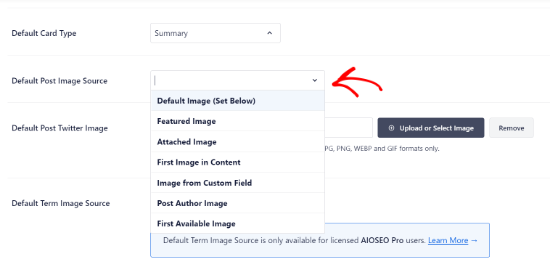
Next, add a Default Post Twitter Image, which will be used as a backup in case your content doesn’t have an image.
For instance, if your post image source is a featured image, but the post is missing a featured image, then Twitter will use the default image instead.
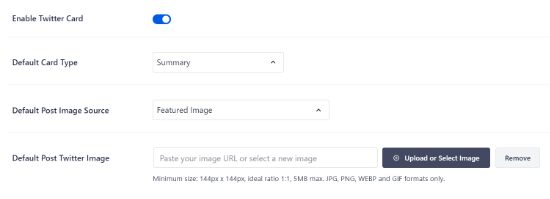
Aside from that, AIOSEO offers more options to show additional data like post author and the time it would take to read an article.
There is also an option to set the Default Term Image Source, but you will need AIOSEO Pro or a higher license to use this feature.
Now, if you scroll down, you will see the home page settings for Twitter. The plugin will show a preview of how your home page will look on a Twitter Card.
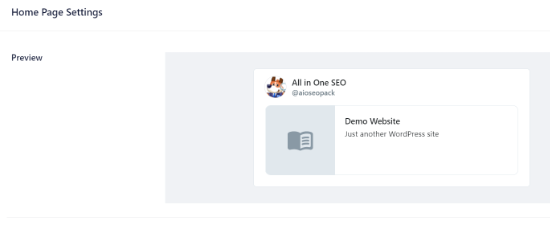
Under this section, you can change the Card Type and add a Home Page Image.
This is similar to the steps we showed earlier, but the difference is that these settings are for your home page.

Next, enter a Home Page Title and Description that will appear on the Twitter Card.
Once that is done, click the ‘Save Changes’ button.
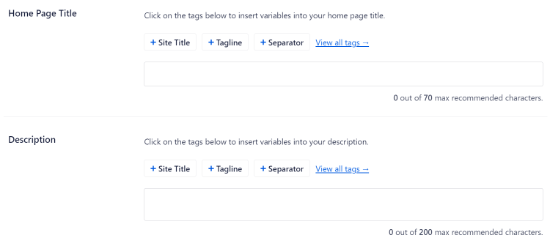
Aside from that, AIOSEO also lets you change the Twitter Card settings for individual posts and pages.
To do that, edit any blog post or page and then scroll down to the AIOSEO Settings in the content editor. Now click on the ‘Social’ tab and select ‘Twitter’.
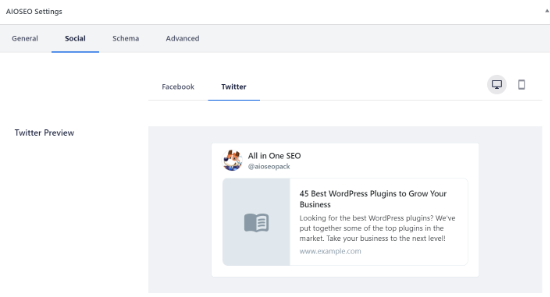
The plugin will show a preview of your post’s Twitter Card and give you the option to use data from the Facebook tab. It also lets you edit the Twitter title and description.
You can write a new title and description or use smart tags. For instance, if you use the ‘+ Post Title’ tag above the Twitter Title field, then AIOSEO will automatically use your post’s title in the Twitter Card.
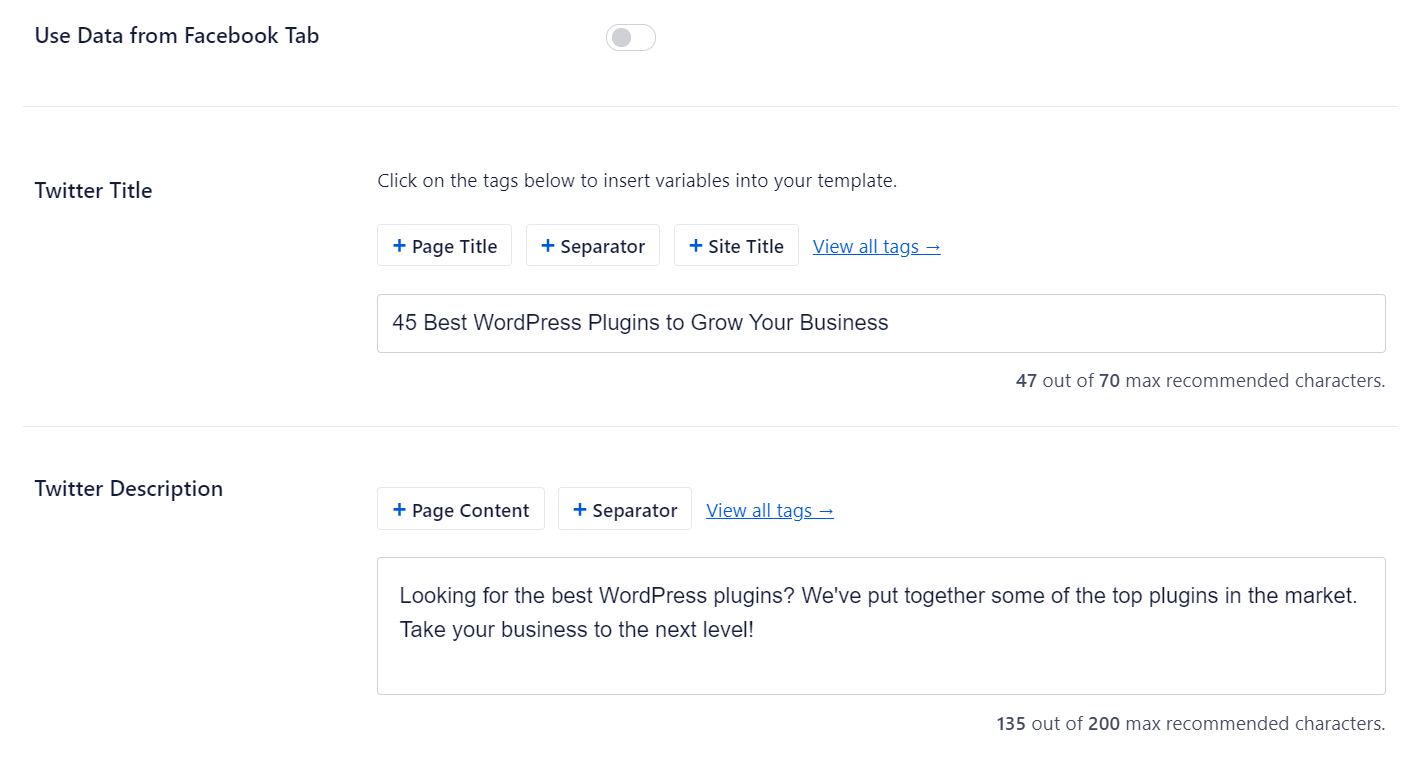
After that, scroll down and select the Image Source for your Twitter Card. Use the drop-down menu to select the image you want to display for your post, like a featured image, attached image, first image in content, and so on.
Lastly, you can select the Twitter Card Type from the drop-down menu. By default, AIOSEO will set it to ‘Summary’, but you can change it to ‘Summary with Large Image.’

Next, update or publish your blog post. You have now successfully added Twitter Cards to your WordPress website.
Method 2: Adding Twitter Cards in WordPress (Code Method)
This method requires adding code to your theme or child theme files. Simply open the header.php file or use the WPCode free plugin to add this custom code just before the </head> tag:
<?php
#twitter cards hack
if(is_single() || is_page()) {
$twitter_url = get_permalink();
$twitter_title = get_the_title();
$twitter_desc = get_the_excerpt();
$twitter_thumbs = wp_get_attachment_image_src( get_post_thumbnail_id($post->ID), full );
$twitter_thumb = $twitter_thumbs[0];
if(!$twitter_thumb) {
$twitter_thumb = 'http://www.gravatar.com/avatar/8eb9ee80d39f13cbbad56da88ef3a6ee?rating=PG&size=75';
}
$twitter_name = str_replace('@', '', get_the_author_meta('twitter'));
?>
<meta name="twitter:card" value="summary" />
<meta name="twitter:url" value="<?php echo $twitter_url; ?>" />
<meta name="twitter:title" value="<?php echo $twitter_title; ?>" />
<meta name="twitter:description" value="<?php echo $twitter_desc; ?>" />
<meta name="twitter:image" value="<?php echo $twitter_thumb; ?>" />
<meta name="twitter:site" value="@libdemvoice" />
<?
if($twitter_name) {
?>
<meta name="twitter:creator" value="@<?php echo $twitter_name; ?>" />
<?
}
}
?>
You can change the ‘twitter:card’ value on Line 14 to ‘summary_large_image’ if you want to display a summary card with a large image.
If you don’t know how to work with PHP or running into issues with Method 2, then please use Method 1.
Test and Validate Your Twitter Cards
Before links from your WordPress site start showing Twitter Cards, you need to first check it in the Twitter card validator.
Simply head over to the Card Validator page on the Twitter developers’ website. Enter the URL of any post from your WordPress site and click on the ‘Preview card’ button.
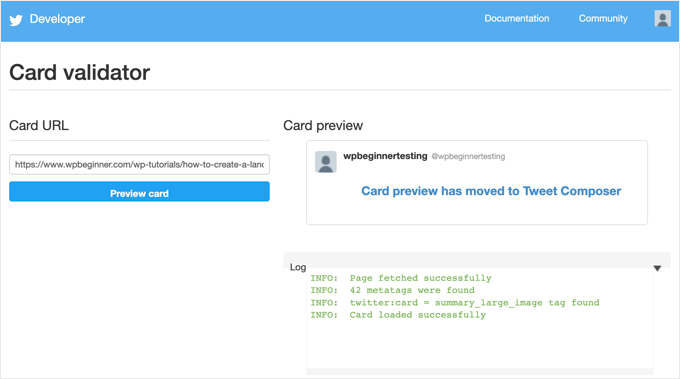
The card validator no longer displays a preview of the tweet, but it does show a log of whether the Twitter card loaded successfully or not.
Update: Previously, you had to apply for participation in the Twitter Cards. However, Twitter has implemented a system that automatically whitelists domains when you test them with the validator or just share a URL on Twitter.
Expert Guides on Using Twitter With WordPress
Now that you know how to add Twitter cards to WordPress, you may like to see some other guides related to using Twitter with WordPress.
- How to Automatically Tweet When You Publish a New Post in WordPress
- How to Add Twitter Share and Retweet Button in WordPress
- How to Embed Actual Tweets in WordPress Blog Posts
- How to Fix Broken Twitter Card Images in WordPress
- How to Display Author’s Twitter and Facebook on the Profile Page
- Best Twitter Plugins for WordPress (Compared)
- How to Display Recent Tweets in WordPress (Step by Step)
- How to Add Your Social Media Feeds to WordPress (Step by Step)
We hope this article helped you add Twitter cards to WordPress. You may also want to see our guide on how to create a landing page with WordPress and our expert pick of the must-have WordPress plugins to grow your website.
If you liked this article, then please subscribe to our YouTube Channel for WordPress video tutorials. You can also find us on Twitter and Facebook.





Syed Balkhi says
Hey WPBeginner readers,
Did you know you can win exciting prizes by commenting on WPBeginner?
Every month, our top blog commenters will win HUGE rewards, including premium WordPress plugin licenses and cash prizes.
You can get more details about the contest from here.
Start sharing your thoughts below to stand a chance to win!
Nick Farrell says
You can also just throw your meta tags right into the body of your post. Not the ideal way, since this creates empty white space where your tags are, but it’s a good workaround for those having trouble.
Laurel says
If the php code above seems to break your site, it could be that your server doesn’t use php short tags (using “<?" as an opening tag instead of "<?php"). Try this version instead:
Prabs says
Hi thanks for the informative post. However I did all this and when testing my site through the card validator, was told it was unable to generate image because my site isn’t whitelisted! Any idea what I can do?
Sarah says
Hi,
I realise this is an old post,
IF you HARDCODE into your header.php; make sure you change the values line 10 and 19 as these point to the contributors account so be sure to change them to yours.
just sayin …
Jahmya says
Hi,
I have done all the steps when I try to validate with twitter it tells me my text description meta tag is missing. I don’t know anything about code so I used the first method. Any help?
sonam says
is it free ?
Tyler says
Finally a helpful tutorial! You would think that Twitter would make it a little simpler to do this. Thank you so much for your help on this!
Michael says
Is there a way to automatically notify the twitter validator when a post/page is updated?
I have a site that gets content published automatically from a source without a featured image so once I manually add the image I also have to manually validate the post/page again to get the cards to show on twitter.
Was hoping there could be some way to automatically ping the twitter validator when a page/post is updated.
Azita says
I don’t know why the code above cut off.
Here is the code am using:
ID), full );
$twitter_thumb = $twitter_thumbs[0];
if(!$twitter_thumb) {
$twitter_thumb = ‘url of imag’;
}
$twitter_name = str_replace(‘@’, ”, get_the_author_meta(‘twitter’));
?>
<meta name="twitter:title" content="” />
<meta name="twitter:description" contente="” />
<meta name="twitter:image" content="” />
Azita says
Thank you so much. I figured out. No worries. Please disregard this comment.
Thank yu again.
Adrian Robertson says
Another awesome post … great stuff!
For anyone having issues with the image being display (I have Summary selected as my Twitter Card option) just make sure you are using a featured image, as this is where it pulls from.
Without this specified, what I saw was my site logo (which was way too big for the Summary image)
Nefeli D says
Can’t thank you enough !
Cheo says
Hi, i’ve made all steps and got the twitter card ok, but the preview image is not loading! what should i do?
WPBeginner Support says
If you are using code method, then please try using the plugin method. If you are already using the plugin method, then try repeating all the steps carefully.
Admin
shamsher says
i have a question that when where to upload it on all pages and post or on home page only.
bcoz when i share any link of my blog on twitter after adding this in header every time same image appears.
Adrian Robertson says
Is it your site logo that appears?
Just check that you have a feature image set against your post, and it should pull from there
Roger Dunkelbarger says
Found this article and followed the steps to set up Twitter Cards since we already had Yoast. We want to use the video Player Card but that doesn’t appear to be an option. Do we need to use a different plug in, or is that option available?
Amanda says
I”m using twitter cards through my Yoast SEO, however when I post I have a link and a view summary button that people have to click to see my pictures. I want the pictures to be auto populated without the need for a click. How do I make that happen?
Here is my twitter account so you can see my tweets for an example
Graham says
All going well with the inclusion of twitter cards. I would like to make the image that displays on twitter link able or to a link underneath to take it to a third part site any ideas?
Oh and by the way I would like to thank you guys for realizing that not everyone degree is in computer science and won at MIT !!
WPBeginner Support says
The image can only be linked to the link you are sharing.
Admin
Tina Marie Ernspiker says
Thank you very much! My blog is white-listed now, with Twitter Cards Whoot, whoot!
Whoot, whoot!
Jas says
Hi,
Thanks for your tutorial. I have tried with above code. But can you please explain how to make Twitter card working for multiple accounts.
I have ten different twitter pages where same post will go out as Twitter card.
So do I need to repeat this below line 10 times with different names:
…..
…
….
….
Please suggest?
Thanks!
jas says
code doesn’t shows in my previous comment I mean to say meta tag with Twitter site name need to get repeated with different names?
<meta name="twitter:creator" value="@” />
Edna says
This was super helpful, thanks!
One quick thing, I noticed the validation link is no longer working. I think this is the Card Validator link now (got it from the twitter blog, seemed to work fine for me):
WPBeginner Support says
Thanks, we have updated the article.
Admin
Maha says
How to request to twitter for approvel my site ..please help me i tried twitter card ,the preview tool say your card is whitelisted ..
riad says
hi i love your site very nice i want to asking you how to change the language of wordpress from franch to english or arabic
WPBeginner Support says
You can change the language from Settings > General page in WordPress admin area.
Admin
Paul Middlebrooks says
The Yoast solution did not work for me. I followed the instructions (3 times to make sure), and the Card Validator sees my metadata but tells me I have no card.
Also, neither the Preview Tool nor the “FIll out This Form” links worked:
https://dev.twitter.com/docs/cards/preview
Maybe this solution is already history?
samiOOTB says
I had done this and Twitter cards were working perfectly for months. Suddenly the past few days they’ve stopped working. What can I do?
Megan Kubasch says
So I have installed WP SEO by Yoast, and I have followed all of the instructions up to the point where I insert the Card URL on the Preview page for the Card Validator on Twitter. What URL am I supposed to Insert? I have used my URL for my blog, but it comes up with an error, saying No Card Found (Card Error). Any help you can provide would be greatly appreciated.
Paula says
It will not do it for a main blog page. You have to enter a post page url. So something like http://www.blogname.com/title-of-blog-post not http://www.blogname.com Hope that helps!
Eric Yoffie says
My twitter card has been approved, but I don’t know how to make it work. Am I supposed to fill out a form? I am a WordPress user.
Lauren Riley says
This is really useful thank you.
One thing, we have enabled this using the WordPress Yoast SEO Plug-in and set up a Twitter card manually entering all of the information on the card validator for one blog post.
This worked, however when I tweet a link to my other blog posts it doesn’t pull through the Twitter card. Do you have to set up the Twitter cards for each blog post or should it do it automatically for each blog post?
Manuel Echeverry says
graciass!!! thank you! finally I managed to submit my request to twitter, hopefully i will get my card approved
Ruth says
Oh, and ps
Do we have to approve each post, or will that be automatic after our first post was approved… Again, thank you
Ruth says
Thanks, it works great, except for one thing: I can’t get an image to be included. How would I do that,
Karan Singh says
when i install this plugin then it is asking for “You’ve just installed WordPress SEO by Yoast. Please helps us improve it by allowing us to gather anonymous usage stats so we know which configurations, plugins and themes to test with” Allow Tracking or not, what should i do,
Allow tracking or not.
Sri Ganesh.M says
The codings are not working for animhut blog. Showing error ! Invalid card type
Kevin says
Hello there. Great guide, thanks!
I’m currently stuck trying to validate twitter:creator. When I look at the source for one of my posts, I don’t see the twitter:creator meta tag at all. Would you mind, pointing me in the right direction? I’m hard-coding it.
Gareth says
Great post – i was struggling to set up twitter cards using a wordpress plug in without realising that Yoast had it in-built!
All set up and awaiting approval – thanks guys
Jason Acidre says
Useful post! Been planning to add Twitter cards on my blog for ages now, and just had the time to tweak it earlier, found this guide very helpful, so thanks.
Reap3RGHS says
Hello,
I having a simple problem. I going to add my twitter username to my profile settings. I just add Reap3R_GHS and turn it into http://reap3r_ghs. What can I do?
Editorial Staff says
That’s weird. Did you post it in the support forum for Yoast to see?
Admin
Reap3RGHS says
Isn’t in Yoast settings but in profile settings…
Julien Maury says
Hi,
It’s great but because we call the excerpt outside the loop (header), people could get bad surprises for their description.
So here is a good snippet from uplifted.net that fixes the problem :
function get_excerpt_by_id($post_id){
$the_post = get_post($post_id); //Gets post ID
$the_excerpt = $the_post->post_content; //Gets post_content to be used as a basis for the excerpt
$excerpt_length = 35; //Sets excerpt length by word count
$the_excerpt = strip_tags(strip_shortcodes($the_excerpt)); //Strips tags and images
$words = explode(‘ ‘, $the_excerpt, $excerpt_length + 1);
if(count($words) > $excerpt_length) :
array_pop($words);
array_push($words, ‘…’);
$the_excerpt = implode(‘ ‘, $words);
endif;
$the_excerpt = ” . $the_excerpt . ”;
return $the_excerpt;
}
Then you might replace get_the_excerpt() with this :
get_excerpt_by_id($post_id)
Thanks.
Julien Maury says
Sorry that wasn’t exactly that :
Call the function this way : get_excerpt_by_id($post->ID) otherwise you’ll get notice !
$post_id is undefined.
Plus get_the_excerpt() is deprecated.
You can also add an esc_attr() on $the_excerpt to avoid broken meta if the excerpt has quotes
Thanks !
Julien Maury says
Finally made a plugin to solve this issue : http://wordpress.org/extend/plugins/jm-twitter-cards/
Main Uddin says
There is no needs to use any code , simply use WordPress SEO by Yoast as Syed Balkhi has said which is the best for Twitter card
Julien Maury says
Hi,
There’s no need to use any code. But still my plugin allows you to choose which type of card you want to use on each post. Moreover you can change meta creator (guest blogging) per each post too. I think it’s worthy
Roy McKenzie says
Totally Worthy!
Manuel Garcia says
When I preview my twitter card, the error says:
“Internal Error. Most likely an fetcher error.”
What to do?
Sai Liou says
Thank you for the article! I went with method #1. In the twitter preview, I’m only seeing the summary of the post and not the image. I’ve updated the robot.txt file to allow twitterbot. However, it’s still not showing any image in the preview. Any thoughts on this? Thank you in advance.
Editorial Staff says
Look in your view:source to see if you have the image tags. The image is usually pulled from your featured image.
Admin
Mattia Frigeri says
Good article. I activated the summary card…
Anyway: how do you change the anchor text name of the website in the attribution below?
For instance yours is “WordPress Beginner”, other sites use “example.com”. In my case it uses my name. How do you manage it? I’d like to show a piede of my URL like “example.com”
David Benson says
Just wanted to let you know that this post saved me HEAPS of time trying to get this to work. Clear, clean and to the point walkthrough. It’s very much appreciated.
A followup question. I added all the steps to my blog, TheSocialChic.com, but I’m curious as to how much time it usually takes for them to turnaround an approval process. Will I get an email or anything when I (or if) I am approved for Twitter cards? No worries if you don’t know, but I greatly appreciate any guidance on this topic.
Thanks again for such a helpful post. Keep up the good work and I will be definitely staying tuned to all future posts.
Editorial Staff says
Approval time varies. In our experience, twitter cards were enabled on our account before we received an email from twitter. But yes, we did receive an email from twitter.
Admin
David Benson says
Thanks for letting me know. Very much appreciated. Keep up the great work with this site. I will be staying tuned.
Bridie Jenner says
I now have this on my site, and very exciting as the first blog post I tried worked – fantastic!
But I’ve tried it with a few others and it’s not showing the summary… any ideas?
Editorial Staff says
Did twitter approve your site yet? Remember, they have to approve the site first.
Admin
Bridie Jenner says
These are great! Just applied to Twitter for mine and will be sharing this. Thanks.
John John says
Awesome article, thank you for all these infos.
Parvez Ansari says
I got “Summary Card” working for me by following method 2 for my website which is built usng wordpress. I inserted the code to generate meta data in the single-page wordpress template.
I want to know “how” and “when” to use “Photo Card”
Editorial Staff says
You would use photocards on photo specific pages. For example if you have a photo blog, then it makes more sense for you to use a photocard.
Admin
Chris Kovalenko says
Setting this up today
Urban Renstrom says
Thank for the twitter card tip.
under my profile my twitter handle was missing, doh…
Brent Pittman says
Wow! Thanks for keeping us updated with the latests. It seems like this will save a lot of time and we won’t have to attribute the source since it is done automatically.
Lisander says
Thanks for the tutorial.. I was wondering what that twitter card on yoast’s plugin was.
But now I know, I hope I get accepted.
Rakesh M. Pawar says
Hello, thanks for article, we’ll try this code to implement Twitter Cards.
I’ve one more question (I know this question is not related to this article): How to get such effects like in your post, when we hover mouse over twitter handle it shows popup with follow button, please tell us how to implement that? Thanks in advance.
Nino Blasco says
Always good articles, congratulations.
I’ll try just the code.
Thank you.